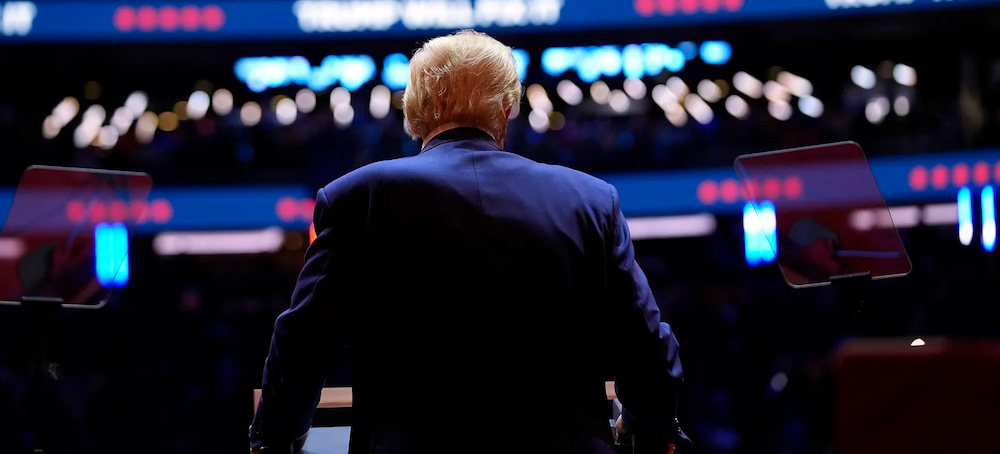No, Trump Cannot Run for Re-Election Again in 2028
Neil Vigdor The New York Times Donald Trump speaks at a campaign rally at Madison Square Garden on October 27, 2024, in New York City. (photo: Alex Brandon/AP)
Donald Trump speaks at a campaign rally at Madison Square Garden on October 27, 2024, in New York City. (photo: Alex Brandon/AP)
The Constitution sets a two-term limit for presidents. Still, Donald J. Trump has repeatedly floated the idea that he might like to stay in the White House beyond his next term.
By the end of his second term, Mr. Trump, now 78, would be the oldest president in history.
Here’s why the issue has surfaced and what the law says:
What is Trump saying about a third term?
Mr. Trump has occasionally sent mixed and cryptic messages about how long he could stay in office.
While talking to House Republicans recently about clinching the White House and both chambers of Congress, Mr. Trump jokingly hinted that they could help prolong his presidency.
“I suspect I won’t be running again unless you say, ‘He’s so good we’ve got to figure something else out,’” Mr. Trump said.
In July, at a gathering of religious conservatives, he told Christians that if they voted him into office in November, they would never need to vote again. “Christians, get out and vote. Just this time,” he said. “You won’t have to do it anymore, you know what? Four more years, it’ll be fixed, it’ll be fine, you won’t have to vote anymore, my beautiful Christians.”
Speaking to members of the National Rifle Association in May, he said: “I don’t know, are we going to be considered three-term or two-term? Are we three-term or two-term if we win?”
And during his first term in office, Mr. Trump suggested to his supporters at a September 2020 rally in Nevada that term limits were not set in stone.
“We’re going to win four more years in the White House,” he said. “And then after that, we’ll negotiate, right? Because we’re probably — based on the way we were treated — we are probably entitled to another four after that.”
Yet when Mr. Trump was asked by a New York Times reporter on Election Day whether the 2024 campaign was his last, he said, “I would think so.”
How presidential term limits came about
The 22nd Amendment to the Constitution, which was ratified in 1951, says that “no person shall be elected to the office of the President more than twice.”
Kimberly Wehle, who teaches constitutional law at the University of Baltimore and wrote a book titled “How to Read the Constitution — and Why,” said that the measure left no ambiguity and was intended to place a check on the president.
“There was a concern about entrenching power in a kinglike manner,” she said.
Can Trump get around the 22nd Amendment?
Mr. Trump has effectively demonstrated an ability to bend the Constitution, Ms. Wehle noted, especially having appointed three of the justices who belong to the Supreme Court’s conservative majority. She pointed to the court’s ruling in July that Mr. Trump was entitled to substantial immunity from prosecution on charges of trying to overturn the last election.
“Trump managed to move the Constitution by doing things no one thought was possible, and then there’s no consequences for what he did,” she said.
But amending the Constitution to get around the two-term limit would be a very tall order.
Two-thirds majorities in both the House and Senate are required just to propose an amendment, far more than the slender majorities Republicans hold in both houses now, or two-thirds of the states have to call for a constitutional convention.
Ratifying an amendment is even more onerous: Three-fourths of all state legislatures — or of those state-level constitutional conventions — must approve it.
Serious, or a joke?
Representative Dan Goldman, Democrat of New York, isn’t treating Mr. Trump’s recent quip as a laughing matter.
Soon after Mr. Trump remarked that House Republicans could help pave his way to a third term, Mr. Goldman said he would introduce a resolution to reaffirm that the 22nd Amendment applies for presidents who serve nonconsecutive terms. The measure has little chance of advancing to the House floor for a vote with the chamber under Republican control.
“How he operates is by floating trial balloons that he often claims are jokes, but he’s very serious about it,” Mr. Goldman, who was lead counsel during Mr. Trump’s first impeachment in the House, said on Bloomberg TV. “And he’s been talking about staying on past this next term for years.”
Representatives for Mr. Trump’s White House transition team did not immediately respond to a request for comment.
Has a president ever served more than two terms?
Yes. President Franklin D. Roosevelt was elected to four terms, serving from 1933 to 1945, during the Great Depression and World War II. He died while in office. There was no 22nd Amendment then, but Roosevelt’s grip on power became a driving force for setting term limits for presidents.
“Four terms, or sixteen years, is the most dangerous threat to our freedom ever proposed,” Thomas E. Dewey said in 1944. He served as New York governor and lost to Roosevelt in 1944 and to Harry S. Truman in 1948.



